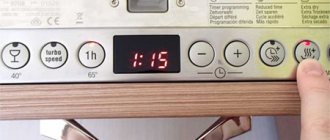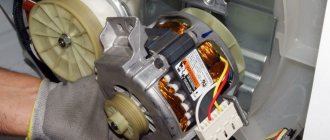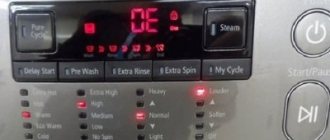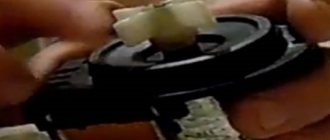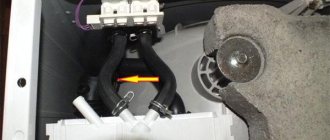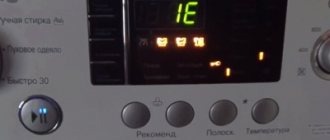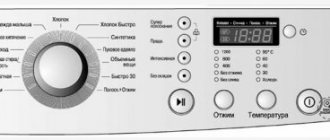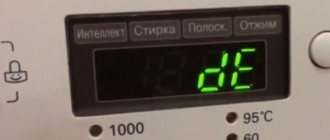Users often encounter a problem where the LG machine does not drain the water. Sometimes the malfunction can be fixed at home, in some cases replacement of parts and major repair of elements is required. In addition, to repair the breakdown, you may need to contact a service center.
If your LG washing machine does not drain water, this may be due to malfunctions in several elements of the device. Therefore, to solve the problem on your own or with the help of a specialist, it is necessary to determine the root cause of the problem.
What to do if the machine breaks down during washing
If a problem with the operation of the machine was discovered during its operation, it should be corrected immediately. To do this, the machine is stopped and disconnected from the network. Then you need to drain the water from the drum. To do this, open the hatch located on the bottom of the device and drain it. Then open the filter and drain the water from it.
These steps allow you to get rid of water accumulated inside the device.
After the machine parts have dried, you can begin a thorough inspection of the parts and their possible repairs.
Water drain options
You can forcefully get rid of water in the following ways:
- Unscrew the tube cap located next to the filter behind the panel and slowly drain the water.
- Water leaves the washing machine standing on the podium if you disconnect the drain hose from the sewer and place it in a container below the level of the machine. This may not work if there is an “aquastop” - a system that blocks the water supply if there is a leak.
- At the bottom of the front panel of the device there is a filter that periodically becomes clogged with debris. Place a tray under it and unscrew it counterclockwise. The task will be made easier by slightly tilting the body forward.
- By moving the machine away from the wall and removing the back panel, you will get to the tube with a clamp installed under the drum. This pipe needs to be removed and cleaned.
The simplest but most effective method is to scoop water out of the drum with a convenient container. Before opening the door, tilt the body back to avoid flooding the floor. Be on the safe side by placing rags around the car.
Draining water from the SMA
Damage to the water level sensor
This reason is quite common. The water level sensor evaluates the amount of liquid in the drum during washing and gives a command to drain it. This process is controlled by a sensor. If it breaks, water is constantly drawn into the drum. In addition, the machine does not drain water or spin things out.
The water level sensor is checked for damage using a multimeter. The values required for correct operation can be clarified in the instructions supplied with the device.
What should I do if my LG washing machine does not drain water or spin clothes?
Nika What to do if the LG washing machine does not drain water and does not spin?
Has your LG washing machine stopped draining waste water and spinning clothes? This means that you are faced with one of the most common problems with this brand of equipment. But before you go to the service center, you can try to fix the problems yourself - then we will tell you and show a video what to do if your LG washing equipment suddenly breaks down.
Drain faults
Before moving on to checking the internal elements of the washing machine, you should rule out the most common problem that can be dealt with without repair - failure of the operating mode. If the equipment stops before the spin stage, it means that there was a failure in its program: simply unplug the machine from the outlet, and then start it immediately from the “Spin” mode. If such a simple check does not produce results, then the problem is inside the machine. The following options are possible here:
- Drain filter malfunction. It often becomes clogged, thereby preventing waste water from leaving the tank into the hose. The filter in LG machines is located in the lower right part of the case. It’s easy to check: open the filter cover and unscrew the part; check the filter for various types of contaminants; clean the filter and screw it back on.
Important! Before checking the filter, be sure to completely empty the washing machine tank.
- Drain hose clogged. Everything is also simple here: disconnect the hose, inspect its internal surfaces and blow it out.
You can fix most washing machine problems without a technician.
- Pump pump malfunction. In this case, you first need to partially disassemble the machine in order to get to the pumping equipment. Then, after unscrewing the pump, you need to clean its wings of lint and threads. If the machine has been used for more than 5 years, it may be necessary to replace the pump.
Advice. Sometimes an LG washing machine blocks drainage due to an electronics malfunction: the module does not signal the need to drain, so the equipment does not react at all. In this case, only flashing or completely replacing the module board will help, but it is better to entrust such work to professionals - you cannot do this without special knowledge.
Spin problems
Low quality or even complete lack of spin in LG machines can cause the following problems:
- Reduced speed - in the event of a mode failure, the equipment can reduce the number of revolutions per minute, so the laundry will remain wet even after spinning. Restarting the program will help here.
- Motor failure - if the device fails, spinning will not be possible. First of all, you need to check the brushes and windings of the motor - it is because of them that the device most often loses power, so it cannot properly spin the drum to perform a spin cycle.
- Malfunction of the tachometer - as a result of a malfunction of the sensor, the machine does not gain the required number of revolutions and cannot provide an effective spin. Most often, the problem arises not because of the sensor itself, but because of the mounting screw - it needs to be either re-tightened or replaced.
- Weakening of the drum belt - if the belt is worn out, it weakens and begins to slip under load, preventing the drum from unwinding. Here the problem will be solved only by replacing the belt.
Advice. Spin problems can be caused by drainage problems, so don’t be lazy to check the hose, the filter, and the pump pump.
As you can see, if your LG washing machine has problems draining water and spinning clothes, in most cases you can quite successfully solve them yourself. Even if he has no experience in repairing such equipment. The main thing is to correctly diagnose the breakdown and understand the rules for eliminating it.
How to drain water from a machine: video
Kinked or clogged drain hose
A fairly common reason that water does not drain may be a kinked or clogged drain hose. A sign of a problem is that the machine begins to hum when it begins the process of draining water.
First of all, the hose is inspected along its entire length to identify any kinks. If they exist, it will not go unnoticed.
If there is a bend, the hose is straightened, after which the problem disappears on its own.
Often the hose becomes clogged. The cause of this phenomenon may be hair from clothing, specks, etc. In such a situation, you can check the hose only by disconnecting it from the device at the place where it connects to the sewer pipe. If the blockage is obvious, it is removed manually. After this, the hose can be further purged. Additionally, the siphon is cleaned. There may also be blockages left in it.
If these problems were not detected, you need to continue diagnosing the device.
Pump failure
Sometimes the breakdown may lie in the drain pump. A sign of a problem is that the machine does not drain water and makes a humming noise. To check the condition of the pump, inspect the pipe, hose and pump.
To conduct a detailed inspection, the machine is disconnected from the network. Then everything needs to be done according to the algorithm:
- Remove the powder compartment.
- Place the LGI washing machine on the left side where it will be convenient to work with it.
- The clamps at the bottom of the machine are loosened and moved down.
- Remove the pipe and wash it, inspect it for damage and stuck objects. After this, you can return it to its place.
- Disconnect the drain hose and check for blockages.
- Unscrew the pump and remove it.
The pump is opened, dividing it into two parts, and the parts are inspected for the presence of contaminants, such as hair, threads or items of clothing.
If there are no foreign elements on the pump, you need to check whether the electrical part of the part is working. To do this, use a multimeter and put it in resistance testing mode.
The result indicates whether the problem with your washing machine is the pump. If the result is 0 or 1, the part should be replaced. If the multimeter shows a different value than the specified value, there is no problem with this part.
Why doesn't the drain in the washing machine work?
A completely fixable situation is when the machine does not drain contaminated water after the first wash. But how can you be sure that this is the problem?
Pay attention to the main signs that the device does not drain water:
- The used water leaves slowly, due to which the operation of the machine is completely disrupted and it cannot function further;
- The device does not drain water only when programmed for certain modes;
- The device works normally from the moment it is started, but the water does not drain out of the washing machine at the stage of washing when this should happen, so the machine does not wring out or rinse things, but stops and malfunctions;
- If the washing machine does not drain the water after the next rinse phase;
- When the water does not go away at the final stage after twisting the laundry.
There can be many reasons why a washing machine does not drain water. We will consider in detail how to identify and, if possible, eliminate them ourselves. Why the washing machine does not drain water, how to find ways to correct the shortcomings and repair the machine.
Here are the most common:
- The water drainage hose that connects the device to the drainage system is clogged with debris. This problem often extends to the siphon, if present;
- Coins, toothpicks, pieces of paper and other debris ended up in the filtration compartment;
- The channel through which water passes from the drum to the pump is clogged;
- When the washing machine does not drain water well and makes a loud monotonous sound, this may indicate a breakdown or minor malfunction of the pump. On average, this part is designed for 5 years of uninterrupted operation. But it can fail even earlier if debris in the form of hair and threads gets into it;
- The automatic device does not drain water if another main element, the impeller, fails. Only a specialist can identify and fix this problem;
- Malfunction of the electronics used to control the machine. This can happen due to fluctuations in electrical voltage in the house or due to the long life of the machine;
- The liquid drainage sleeve is long enough. A standard pump can pump out water if the distance from it to the sewer pipe is no more than one and a half meters. In another case (for example, after moving the device to another place and replacing the sleeve), it may not cope and here we are not talking about a breakdown at all.
Pressostat malfunction
If the washing machine does not drain water, the problem could arise from a breakdown of the part with the sensor - the pressure switch. In a washing machine, it is responsible for measuring the water level in the drum. This allows you to drain it in time, depending on the washing mode and the stage of its implementation.
The main sign of a sensor failure is water in the drum at the moment when the machine should drain it. Sometimes it happens that the machine suddenly stops squeezing things out. The sensor does not work, so the water does not drain, and the spin process does not start in this case.
You can diagnose a breakdown using a standard multimeter, which will indicate a fault, if any.
To check if the sensor is broken, unscrew two screws from the back of the machine and remove the cover. A pressure switch will be located at the top right of the front of the case. In order to remove it, unscrew the fasteners, disconnect the wiring and hose.
You need to check the following components of the pressure switch:
- The case for mechanical damage. If one of the parts of the device has cracks, chips, or rotten areas, it must be replaced.
- Hose. It should not have blockages, strong kinks or cracks along its entire length.
- Wiring. In this case, the integrity of the wiring must be checked.
If no faults are found, proceed to the next stage of checking the operation of the washing machine.
Failure of the control board
If, as a result of the described types of diagnostics of the machine, the problem was not identified, the possible cause of the breakdown may lie in the failure of the control board. This can happen due to a number of factors:
- exposure to lightning, voltage surges;
- getting the board wet when in contact with water;
- improper operation;
- poor soldering of tracks in the control module.
With this type of problem, the machine can behave differently: not work at all, not support one of the washing modes, uncontrollably draws in and drains water, leaves things unwrung.
It is not recommended to try to fix the problem yourself. The fact is that as a result of the owner’s actions, the machine may fail completely. In this case, it is necessary to contact the service center.

